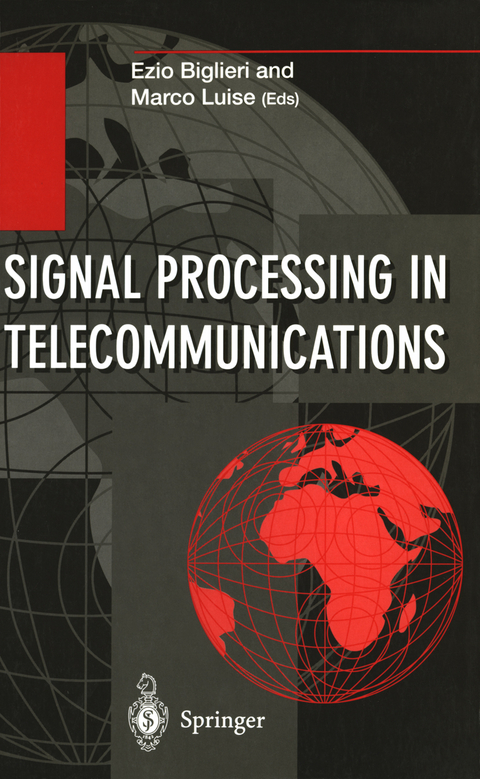
Signal Processing in Telecommunications
Springer Berlin (Verlag)
978-3-540-76019-1 (ISBN)
1 Applications of DSP to Personal Communication Networks.- BER Comparison of DS-CDMA and MC-CDMA for Frequency Selective Fading Channels.- Performance Enhancement of Indoor Channels Using Quasi-Coherent Combining of Multiple Antenna Signals.- Applications of Walsh Functions and the FHT in CDMA Technology.- Decision Feedback Multi-User Detection for Multitone CDMA Systems.- Blind Adaptive Interference-Cancelling Detectors for DS/SS CDMA: Algorithms and Performance.- The Bootstrap Decorrelating Algorithm: A Promising Tool for Adaptive Separation of Multi-User CDMA Signals.- 2 Joint Source/Channel Coding for Multimedia Applications.- Rate-Distortion Performance of Several Joint Source and Channel Coding Schemes for Images.- Bounds on the Performance of Vector Quantizers operating under Channel Errors over all Index Assignments.- Adaptive Temporal & Spatial Error Concealment Measures in MPEG-2 Video Decoder with Enhanced Error Detection.- Source and Channel Coding Issues for ATM Networks.- Combined Source and Channel Coding for Wireless ATM LANs.- 3 DSP in Channel Estimation/Equalization and Modem Design.- Block-by-Block Channel and Sequence Estimation for ISI/Fading Channels.- Timing Correction by Means of Digital Interpolation.- Digital Demodulator Architectures for BandPass Sampling Receivers.- Quadrature Phase Error and Amplitude Imbalance Effects on Digital Demodulator Performance.- Maximum-Likelihood Sequence Estimation for OFDM.- A New Analysis Method for the Performance of BandPass Sampling Digital Demodulators Considering IF Filter Effects.- Comparison of Demodulation Techniques for MSK.- Variable Symbol-rate Modem Design for Cable and Satellite TV Broadcasting.- A New Class of Carrier Frequency and Phase Estimators Suited for MPSK Modulation.- 4 Signal Processingin Satellite Networks.- Payload Digital Processor Hardware Demonstration for Future Mobile and Personal Communication Systems.- Frequency Domain Switching: Algorithms, Performances, Implementation Aspects.- Design Study for a CDMA Based LEO Satellite Network: Downlink System Level Parameters.- A Multi-user Approach to Combating Co-channel Interference in Narrow band Mobile Communications.- Digital Radio for the World: High-Grade Service Quality Through On-Board Processing Techniques.- 5 Advanced Signal Processing Techniques.- Digital Equalization using Modular Neural Networks: an Overview.- Vector Quantization Using Artificial Neural Network Models.- Neural Networks for Communications and Signal Processing: Overview and New Results.- Transform-Domain Signal Processing in Digital Communications.- Fuzzy-Rule-Based Phase Estimator Suited for Digital Implementation.- 6 Recent Applications of DSP Techniques.- Analog Envelope Constrained Filters for Channel Equalization.- Design of All-Digital Wireless Spread-Spectrum Modems Using High-Level Synthesis.- Efiicient VHDL Code Generation for Digital Receiver Design.- Blind Joint Equalization of Multiple Synchronous Mobile Users for Spatial Division Multiple Access.- Base-Station Antenna Arrays in Mobile Communications.
| Erscheint lt. Verlag | 1.4.1996 |
|---|---|
| Reihe/Serie | Information Technology: Transmission, Processing and Storage |
| Zusatzinfo | XI, 454 p. 28 illus. |
| Verlagsort | London |
| Sprache | englisch |
| Maße | 155 x 235 mm |
| Gewicht | 705 g |
| Themenwelt | Informatik ► Grafik / Design ► Digitale Bildverarbeitung |
| Mathematik / Informatik ► Informatik ► Theorie / Studium | |
| Technik ► Elektrotechnik / Energietechnik | |
| Technik ► Nachrichtentechnik | |
| Schlagworte | Bandpass • Communication • Interpolation • Modulation • Signal Processing • Switch • Symbol • System |
| ISBN-10 | 3-540-76019-9 / 3540760199 |
| ISBN-13 | 978-3-540-76019-1 / 9783540760191 |
| Zustand | Neuware |
| Haben Sie eine Frage zum Produkt? |
aus dem Bereich


